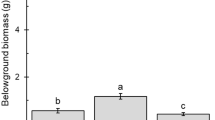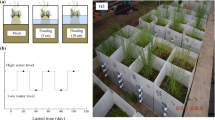Abstract
The objective of this study is to determine the effects of substrate moisture and oxygen availability on growth traits of Salix gracilistyla Miquel, which colonizes gravel bars along rivers, the shoot growth schedule, biomass production, and resource allocation were examined under greenhouse conditions. We used four treatments representing a range of substrate moisture and oxygen availability: drought (D), flooding with standing water (FS), flooding with running water (FR), and control without drought or flooding (C). Cuttings in D stopped flushing and had low biomass production, reduced total leaf mass, and small leaves. Under anaerobic conditions, cuttings in FS stopped flushing and had low biomass production, small root biomass, low biomass allocation to roots, shallow roots, high biomass allocation to hypertrophied lenticels, and a few small, thick leaves. Under aerobic conditions, cuttings in FR showed continuous branch elongation and flushing, large biomass production, and large leaf biomass, similar to cuttings in C, in addition to low allocation to hypertrophied lenticels and many large leaves. The growth of cuttings was not inhibited by flooding of the roots throughout the experiment unless the conditions were anaerobic. Thus, cuttings respond to water stress under low moisture conditions by reducing the transpiration area and respond to flooding under low oxygen conditions by high allocation to hypertrophied lenticels and reduced transpiration area. Plasticity in the shoot growth schedule, biomass production, and resource allocation according to moisture conditions and the ability to develop hypertrophied lenticels upon flooding allow S. gracilistyla to colonize sites in which both desiccation and flooding occur.






Similar content being viewed by others
References
Amlin NA, Rood SB (2001) Inundation tolerances of riparian willows and cottonwoods. Water Resour Assoc 37:1709–1720. doi:10.1111/j.1752-1688.2001.tb03671.x
Angeles G, Evert RF, Kozlowski TT (1986) Development of lenticels and adventitious roots in flooded Ulmus americana seedlings. Can J Res 16:585–590. doi:10.1139/x86-101
Arbona V, Iglesias DJ, Jacas J, Primo-Millo E, Talon M, Gomez-Cadenas A (2005) Hydrogel substrate amendment alleviates drought effects on young citrus plants. Plant Soil 270:73–82. doi:10.1007/s11104-004-1160-0
Armstrong W, Drew MC (2002) Root growth and metabolism under oxygen deficiency. In: Waisel Y, Eshel A, Kafkafi U (eds) Plant roots: the hidden half. Marcel Dekker, USA, pp 729–761
Asseng S, Milroy SP, Poole ML (2008) Systems analysis of wheat production on low water-holding soils in a Mediterranean-type environment I. Yield potential and quality. Field Crops Res 105:97–106. doi:10.1016/j.fcr.2007.08.003
Beismann H, Wilhelmi H, Bailleres H, Spatz HC, Bogenrieder A, Speck T (2000) Brittleness of twig bases in the genus Salix: fracture mechanics and ecological relevance. J Exp Bot 51:617–633. doi:10.1093/jexbot/51.344.617
Bertani A, Brambilla I (1982) Effect of decreasing oxygen concentration on wheat roots: growth and induction of anaerobic metabolism. Z Pflanzenphysiol 108:283–288
DeLaune RD, Pezeshki SR (1991) Role of soil chemistry in vegetative ecology of wetlands. Trends Soil Sci 1:101–113
Dewitt L, Reid DM (1992) Branch abscission in balsam poplar (Populus balsamifera): characterisation of the phenomenon and the influence of wind. Int J Plant Sci 153:556–564. doi:10.1086/297079
Dionigi CP, Mendelssohn IA, Sullivan VI (1985) Effects of soil waterlogging on the energy status and distribution of Salix nigra and S. exigua (Salicaceae) in the Atchafalaya River basin of Louisiana. Am J Bot 72:109–119. doi:10.2307/2443573
Donovan LA, McLeod KW, Sherrod KCJ, Stumpff NJ (1988) Response of woody swamp seedlings to flooding and increased water temperatures I. Growth, biomass, and survivorship. Am J Bot 75:1181–1190. doi:10.2307/2444101
Drew MC (1990) Sensing soil oxygen. Plant Cell Environ 13:681–696. doi:10.1111/j.1365-3040.1990.tb01083.x
Hook DD, Brown CL, Kormanik PP (1970) Lenticels and water root development of swamp tupelo under various flooding condition. Bot Gaz 131:217–224. doi:10.1086/336535
Horton JL, Kolb TE, Hart SC (2001) Responses of riparian trees to interannual variation in ground water depth in a semi-arid river basin. Plant Cell Environ 24:293–304. doi:10.1046/j.1365-3040.2001.00681.x
Houle G, Babeux P (1993) Temporal variations in the rooting ability of cuttings of Populus balsamifera and Salix planifolia from natural clones-populations of subarctic Quebec. Can J For Res 23:2603–2608. doi:10.1139/x93-323
Ishikawa S (1982) Ecological studies of the floodplain willow forests in the Tohoku district (in Japanese with English abstract). Res Rep Kochi Univ Natur Sci 31:95–104
Ishikawa S (1997) Distribution behavior of riparian plants and species diversity of the vegetation on rocky river banks in the Yoshino river in Shikoku, Japan. Mem Fac Sci Kochi Univ Ser D Biol 18:1–7
Jackson MB (1985) Ethylene and the responses of plants to soil waterlogging and submergence. Annu Rev Plant Physiol 36:145–174. doi:10.1146/annurev.pp.36.060185.001045
Jackson MB, Attwood PA (1996) Roots of willow (Salix viminalis L) show marked tolerance to oxygen shortage in flooded soils and in solution culture. Plant Soil 187:37–45. doi:10.1007/BF00011655
Jonasson S, Callaghan TV (1992) Root mechanical properties related to disturbed and stressed habitats in the Arctic. New Phytol 122:179–186. doi:10.1111/j.1469-8137.1992.tb00064.x
Jones DT, Sah JP, Ross MS, Oberbauer SF, Hwang B, Jayachandran K (2006) Responses of twelve tree species common in Everglades tree islands to simulated hydrologic regimes. Wetlands 26:830–844. doi:10.1672/0277-5212(2006)26[830:ROTTSC]2.0.CO;2
Karrenberg S, Edwards PJ, Kollmann J (2002) The life history of Salicaceae living in the active zone of floodplains. Freshw Biol 47:733–748. doi:10.1046/j.1365-2427.2002.00894.x
Kitamura S, Murata G (1979) Colored illustrations of woody plants of Japan vol. II (in Japanese). Hoikusha Publishing, Osaka
Kludze HK, DeLaune RD (1994) Methane emission and growth of Spartina patens in response to soil redox intensity. Soil Sci Soc Am J 58:1838–1845
Kozlowski TT (1984) Responses of woody plants to flooding. In: Kozlowski TT (ed) Flooding and plant growth. Academic Press, Orlando, pp 129–163
Kramer PJ (1940) Causes of decreased absorption of water by plants in poorly aerated media. Am J Bot 27:216–220. doi:10.2307/2436882
Kramer PJ, Jackson WJ (1954) Causes of injury to flooded tobacco plants. Plant Physiol 29:241–249. doi:10.1104/pp.29.3.241
Kranjcec J, Mahoney JM, Rood SB (1998) The responses of three riparian cottonwood species to water table decline. For Ecol Manage 110:77–87
Krasny ME, Zasada JC, Vogt KA (1988) Adventitious rooting of four Salicaceae species in response to a flooding event. Can J Bot 66:2597–2598
Larcher W (1980) Physiological plant ecology. Springer, Berlin Heidelberg New York
Li S, Pezeshki SR, Goodwin S, Shields FD (2004) Physiological responses of black willow (Salix nigra) cuttings to a range of soil moisture regimes. Photosynthetica 42:585–590. doi:10.1007/S11099-005-0017-y
Mahoney JM, Rood SB (1998) Streamflow requirements for cottonwood seedlings recruitment—an integrative model. Wetlands 18:634–645
Nakai A, Kisanuki H (2007a) Effect of elevation above the waterline on the growth of current-year Salix gracilistyla seedlings on a gravel bar (in Japanese with English abstract). J Jpn For Soc 89:1–6. doi:10.4005/jjfs.89.1
Nakai A, Kisanuki H (2007b) Effect of inundation duration on Salix gracilistyla density and size on a gravel bar. J For Res 12:365–370. doi:10.1007/s10310-007-0027-7
Niiyama K (1987) Distribution of salicaceous species and soil texture of habitats along the Ishikari River (in Japanese with English abstract). Jpn J Ecol 37:163–174
Niiyama K (1989) Distribution of Chosenia arbutifolia and soil texture of habitats along the Satsunai River (in Japanese with English abstract). Jpn J Ecol 39:173–182
Pezeshki SR (1993) Differences in patterns of photosynthetic responses to hypoxia in flood-tolerant and flood-sensitive tree species. Photosynthetica 28:423–430
Pezeshki SR (2001) Wetland plant responses to soil flooding. Environ Exp Bot 46:299–312. doi:10.1016/S0098-8472(01)00107-1
Pezeshki SR, Anderson PH, Shields FDJ (1998) Effects of soil moisture regimes on growth and survival of black willow (Salix nigra) posts (cuttings). Wetlands 18:460–470
Ponnamperuma FN (1972) The chemistry of submerged soil. Adv Agron 24:29–96. doi:10.1016/S0065-2113(08)60633-1
Ponnamperuma FN (1984) Effects of flooding on soils. In: Kozlowski TT (ed) Flooding and plant growth. Academic Press, New York, pp 1–44
Schaff SD, Pezeshki SR, Shields FDJ (2003) Effects of soil conditions on survival and growth of black willow cuttings. Environ Manage 31:748–763. doi:10.1007/s00267-002-2909-y
Takai Y, Wada H, Kagawa H, Kobo K (1974) Microbial mechanism of effects of water percolation on Eh, iron, and nitrogen transformation in the submerged paddy soils. Soil Sci Plant Nutr 20:33–45
Ueno N, Kanno H, Seiwa K (2006) Sexual differences in shoot and leaf dynamics in the dioecious tree Salix sachalinensis. Can J Bot 84:1852–1859. doi:10.1139/B06-142
van Splunder I, Voesenek LACJ, Coops H, de Vries XJA, Blom CWPM (1996) Morphological responses of seedlings of four species of Salicaceae to drought. Can J Bot 74:1988–1995. doi:10.1139/b96-238
Vischer D, Oplatka M (1998) Der Stromungswiderstand eines flexiblen Ufer- und Vorlandbewuchses. Wasserwirtschaft 88:1–5
Voesenek LACJ, Colmer TD, Pierik R, Millenaar FF, Peeters AJM (2006) How plants cope with complete submergence. New Phytol 170:213–226. doi:10.1111/j.1469-8137.2006.01692.x
Wikberg J, Ogren E (2004) Interrelationships between water use and growth traits in biomass-producing willows. Trees 18:70–76. doi:10.1007/s00468-003-0282-y
Yagi K, Minami K, Ogawa Y (1998) Effects of water percolation on methane emission from rice paddies: a lysimeter experiment. Plant Soil 198:193–200. doi:10.1023/A:1004379914540
Acknowledgments
The authors thank Nakasu M, Minami H, Nakamura Y, Maeda A, and Kawasaki T, and other colleagues for their assistance with the survey. The editor and two anonymous reviewers are also thanked for useful comments and suggestions.
Author information
Authors and Affiliations
Corresponding author
About this article
Cite this article
Nakai, A., Yurugi, Y. & Kisanuki, H. Growth responses of Salix gracilistyla cuttings to a range of substrate moisture and oxygen availability. Ecol Res 24, 1057–1065 (2009). https://doi.org/10.1007/s11284-009-0583-8
Received:
Accepted:
Published:
Issue Date:
DOI: https://doi.org/10.1007/s11284-009-0583-8




